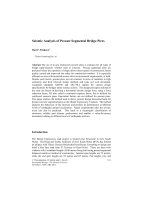Bridges

- Publication no: ABC-DES037-11
- Published: 31 October 2011
- PDF (free) Download
The use of in-situ reinforced concrete piers is common for all types of bridge superstructure, whether steel or concrete. Precast segmental piers are preferred where the repetition of shape allows faster speed of construction, better quality control and improved site safety for construction workers. It is especially efficient on sites with restricted access, strict environmental requirements, or both. Despite such merits, precast piers are not common in areas of moderate to high seismicity and their relevant design methods and tools not well developed. Australian standards AS5100 and AS1170.4 capture the current design specifications for bridges under seismic actions. The design principles outlined in the code are based on deriving a horizontal seismic design force using a force reduction factor, Rf, also called a structural response factor; this is defined for reinforced concrete piers. Equivalent factors are not defined for precast piers. This paper outlines the method used to derive seismic design horizontal loads for precast concrete segmental piers on the Hunter Expressway Viaducts. The method analyses the behaviour of the structure and predicts its performance at different levels of earthquake ground acceleration. Repair requirements after the seismic event can also be predicted. This leads to a meaningful classification of structures, reliable post disaster performance and enables a value-for-money assessment relating to different levels of earthquake motions.
